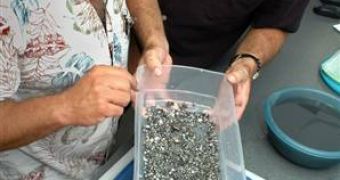It could be good luck or technological progress that makes this possible, but the number of ancient sunken treasures has started to rise.
Shipwreck investigators have found thousands of pearls on Friday after opening a small, lead box encountered while searching for the wreckage of the 17th-century Spanish galleon Santa Margarita.
Divers from Blue Water Ventures of Key West stated they discovered the sealed lead box, of 3.5 inches by 5.5 inches (9 by 14 cm), but also a gold bar, eight gold chains and hundreds of other artifacts at the beginning of this week.
The shipwreck was found buried beneath the ocean floor in about 18 ft (5.5 m) of water about 40 miles (64 km) west of Key West. "There are several thousand pearls starting from an eighth of an inch to three-quarters of an inch. We have no idea exactly how many, because we haven't counted them yet." said Duncan Mathewson, marine archaeologist and partner in Blue Water Ventures.
"The pearls are very rare because of their antiquity and condition. Pearls don't normally survive in the ocean very well once they've lost the protection of the oyster that makes them. In this instance, we had a lead box and the silt that had sifted into the box from the site of the Margarita, which preserved the pearls in a fairly pristine state." said James Sinclair, archaeologist and conservator consulting with Mel Fisher's Treasures, Blue Water's joint-venture partners.
An initial share of the Santa Margarita, sunk by a hurricane in 1622 while heading towards Spain, treasure and artifacts was found in 1980 by pioneering shipwreck salvor Mel Fisher. The pearls will be preserved, documented and photographed in a lab located above the Mel Fisher Maritime Museum, Key West. "Until they're properly cleaned and conserved we don't know their value, but it would seem they would be worth upwards of a million dollars," said Mathewson.
One month ago, deep-sea explorers have encountered the richest sunken treasure ever found, about 500,000 of 17th century silver and gold coins, estimated at about $500 million on a shipwreck in the Atlantic Ocean, off European coasts. The discovery belonged to Odyssey Marine Exploration, based on Tampa, (also!) Florida.

 14 DAY TRIAL //
14 DAY TRIAL //